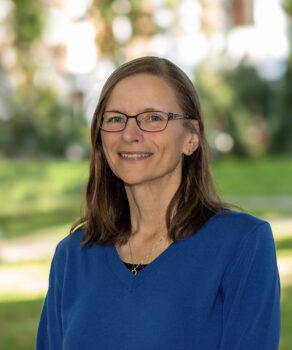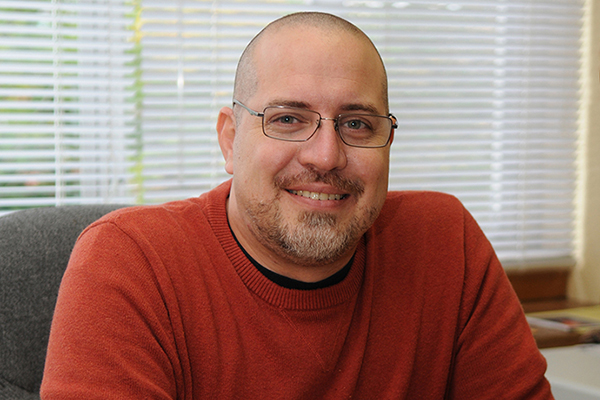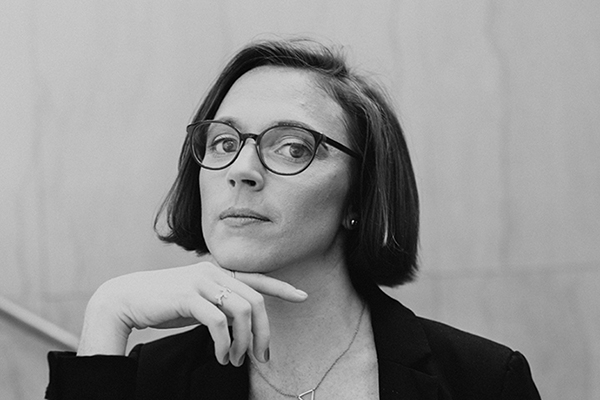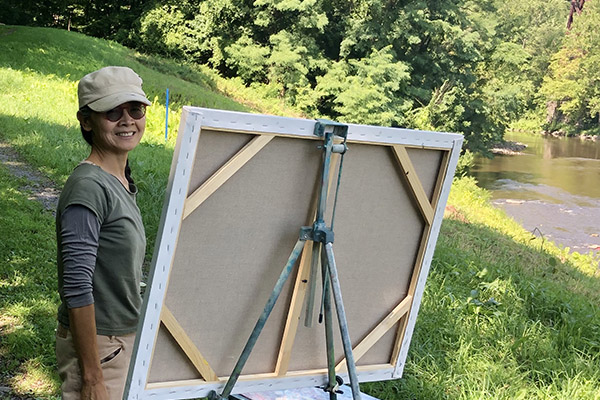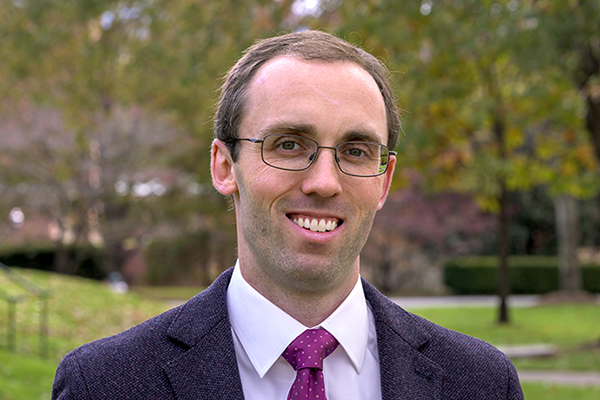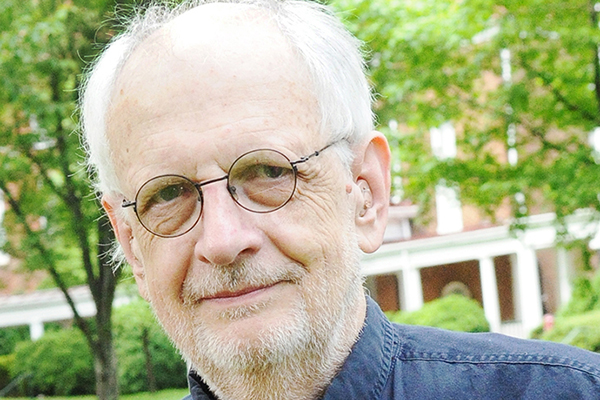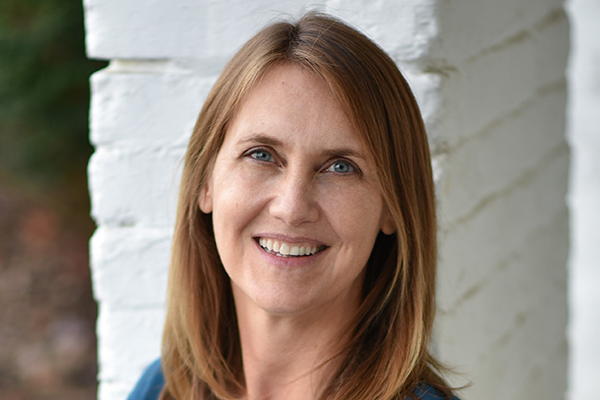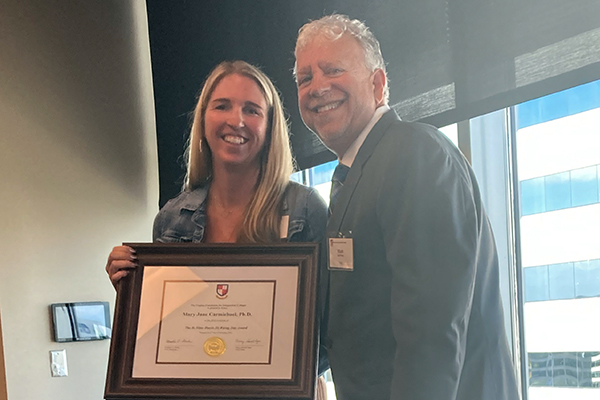Cell towers have become a ubiquitous 21st century presence, so common that most people hardly notice them anymore. Amy Gerber-Stroh, associate professor of film at Hollins University, is the observant exception.
“High above they are watching us, listening to us, and digesting us,” she says. “At first you never see them, but once you start actively looking, you realize that they are everywhere.”
Gerber-Stroh is fascinated with the ways in which cell technology has impacted society, and imagines the possibilities if cell towers actually developed consciousness. “What does it mean to have these looming totem poles on our landscape? Knowing that millions of bits of data go through cell towers every day, could they tell us something about ourselves if they could speak? What would they say? These questions creep into my mind whenever I spot the strange, inconspicuous metallic structures that dominate our space much like telegraph poles once did in the 19th century. Today the air is alive with signals from all directions, some clean, some not, both in terms of content and form. Are cell towers nostalgic for their wooden telegraph ancestors who channeled signals that were simple and pure?”
Gerber-Stroh explores these scenarios in her latest film, Do Cell Towers Dream of Morse Code? Shot in Roanoke, the 27-minute production was honored with the Silver Award for Experimental Works at the 2020 University Film and Video Conference (home of the Journal of Film and Video), and also earned awards and acclaim at the Miami International Sci-Fi Film Festival and Chicago’s International Art House Film Festival. (Please note that the film contains adult language and is intended for mature audiences.)
“In Do Cell Towers Dream of Morse Code?, Gerber-Stroh presents us with a vision of an artificial intelligence that, after being forced to ‘consume’ the suffering and pain of others, wants to have a say in the outcomes it can only witness,” says Vincenzo Mistretta, professor of film production at the University of Southern Mississippi. “The film beautifully captures humanity’s collective cognitive dissonance at the prospect of trying to untangle the borders between real and virtual, connected and alienated, human and non-human. As these categories continue to collapse into one another, our own lives may become increasingly difficult to navigate.”
Do Cell Towers Dream of Morse Code? begins with a “breaking news” teaser from a fictional TV channel: In an “increasingly disturbing situation,” cell towers are catching fire across the country, inexplicably and at an alarming rate.

The film then shifts to a point of view from above two adjacent city parking lots at night, and eavesdrops on the text conversations of three unrelated characters who are waiting there: “Kate” is picking up her son from music lessons; “Amanda” is looking forward to meeting a date for the evening; and “Daniel” claims he is heading to the nearby Y to work out.
“Amongst the scores of parked cars at night in any town or city, one may find a collection of glowing blue light that shines through the fog and condensation of their windows,” Gerber-Stroh says. “The inhabitants think they are alone as they perform a symphony of chords in gigahertz, willingly offering up their electromagnetic fields of hopes, dreams, and fears. But they are not alone. A cell tower is always nearby.”
Solely through their text messages, the film gradually reveals that each character’s story is far more complex that it initially appears. Kate, a single parent, is struggling with a personal financial crisis. Amanda’s date’s ex-boyfriend is jealous and possibly violent. Daniel is in fact a stalker. The tension grows when three men drive into the lot and begin acting oddly after they step outside their vehicle.
Meanwhile, a technician who arrives at the cell tower to do maintenance starts receiving cryptic messages on his work laptop. Dismissing the communications as the work of hackers, the tech is incredulous when the source claims to be an artificial intelligence that has become sentient – the cell tower itself. Proclaiming it is “ill” from “information fatigue,” the cell tower shares its dilemma: “As you might surmise, the world goes through us. We see everything, yet we can do nothing. It is eating us alive. Like a cancer. Or to be more precise: like consuming multitudes of fast food.”
The tower concludes, “Knowledge is worthless without action,” and sets itself on fire. Climbing back down to street level to escape the danger, the technician receives a final video message from the tower that, as Mistretta explains, “guides the repairman toward noticing the real world. It accomplishes its goal to have a real effect on the physical world.”
At its core, Gerber-Stroh believes Do Cell Towers Dream of Morse Code? “offers a brief view from an observer at a unique vantage point. We experience a witness’ fixed perspective of events that occur on a supposed benign street corner. Who is the witness? And what is the witness’ connection to the lone souls below, parked in cars and affixed to their smartphones? The film captures a linear moment in time, exploring the ideas of connectedness and isolation, detachment and engagement, that sometimes occur simultaneously in our modern world.”
A member of the Hollins faculty since 2007, Gerber-Stroh chairs the university’s film department and co-directs the M.A. and M.F.A. programs in screenwriting and film studies. Her films have won honors at numerous film festivals and professional venues, including the Edinburgh International Film Festival; Mill Valley Film Festival; Film Forum, Los Angeles; and Women in the Director’s Chair in Chicago.
Gerber-Stroh’s documentary, My Grandfather Was a Nazi Scientist: Opa, von Braun and Operation Paperclip, was shown at the Charles Guggenheim Center for Documentary Film and also received several other film festival and honorary screenings. Amazon describes it as “a very interesting account of events that are rarely covered in our nation’s history. The film chronicles Gerber’s personal journey to discover and uncover her grandfather’s role in post-war America.”
Russia Was a Woman, Gerber-Stroh’s award-winning screenplay, is gaining some interest at Rooster Teeth and Netflix as a possible limited series. In its review, Fresh Voices calls the work “an interesting revisionist take on Ivan the Terrible’s wife,” and praises Gerber-Stroh for her “ambition, imagination and creation of two lead LGBT characters.”
Gerber-Stroh has had significant professional film experience in Hollywood and New York. She worked on several movie features by Roger Corman and casted 12 major motion pictures including The Mask of Zorro (Columbia Pictures), Goldeneye (MGM), Afterglow (Sony Pictures Classics), Tank Girl (United Artists), and Angels in the Outfield (Disney).




